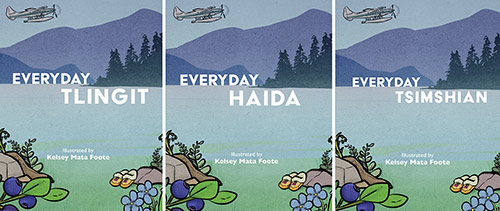SHI publishes illustrated dictionary series for Tlingit, Haida and Tsimshian languages

Sealaska Heritage Institute Press Release
SHI PUBLISHES ILLUSTRATED DICTIONARY SERIES FOR TLINGIT, HAIDA AND TSIMSHIAN LANGUAGES
Trilogy intended for young language learners, others
/*! elementor - v3.21.0 - 08-05-2024 */ .elementor-widget-divider{--divider-border-style:none;--divider-border-width:1px;--divider-color:#0c0d0e;--divider-icon-size:20px;--divider-element-spacing:10px;--divider-pattern-height:24px;--divider-pattern-size:20px;--divider-pattern-url:none;--divider-pattern-repeat:repeat-x}.elementor-widget-divider .elementor-divider{display:flex}.elementor-widget-divider .elementor-divider__text{font-size:15px;line-height:1;max-width:95%}.elementor-widget-divider .elementor-divider__element{margin:0 var(--divider-element-spacing);flex-shrink:0}.elementor-widget-divider .elementor-icon{font-size:var(--divider-icon-size)}.elementor-widget-divider .elementor-divider-separator{display:flex;margin:0;direction:ltr}.elementor-widget-divider--view-line_icon .elementor-divider-separator,.elementor-widget-divider--view-line_text .elementor-divider-separator{align-items:center}.elementor-widget-divider--view-line_icon .elementor-divider-separator:after,.elementor-widget-divider--view-line_icon .elementor-divider-separator:before,.elementor-widget-divider--view-line_text .elementor-divider-separator:after,.elementor-widget-divider--view-line_text .elementor-divider-separator:before{display:block;content:"";border-block-end:0;flex-grow:1;border-block-start:var(--divider-border-width) var(--divider-border-style) var(--divider-color)}.elementor-widget-divider--element-align-left .elementor-divider .elementor-divider-separator>.elementor-divider__svg:first-of-type{flex-grow:0;flex-shrink:100}.elementor-widget-divider--element-align-left .elementor-divider-separator:before{content:none}.elementor-widget-divider--element-align-left .elementor-divider__element{margin-left:0}.elementor-widget-divider--element-align-right .elementor-divider .elementor-divider-separator>.elementor-divider__svg:last-of-type{flex-grow:0;flex-shrink:100}.elementor-widget-divider--element-align-right .elementor-divider-separator:after{content:none}.elementor-widget-divider--element-align-right .elementor-divider__element{margin-right:0}.elementor-widget-divider--element-align-start .elementor-divider .elementor-divider-separator>.elementor-divider__svg:first-of-type{flex-grow:0;flex-shrink:100}.elementor-widget-divider--element-align-start .elementor-divider-separator:before{content:none}.elementor-widget-divider--element-align-start .elementor-divider__element{margin-inline-start:0}.elementor-widget-divider--element-align-end .elementor-divider .elementor-divider-separator>.elementor-divider__svg:last-of-type{flex-grow:0;flex-shrink:100}.elementor-widget-divider--element-align-end .elementor-divider-separator:after{content:none}.elementor-widget-divider--element-align-end .elementor-divider__element{margin-inline-end:0}.elementor-widget-divider:not(.elementor-widget-divider--view-line_text):not(.elementor-widget-divider--view-line_icon) .elementor-divider-separator{border-block-start:var(--divider-border-width) var(--divider-border-style) var(--divider-color)}.elementor-widget-divider--separator-type-pattern{--divider-border-style:none}.elementor-widget-divider--separator-type-pattern.elementor-widget-divider--view-line .elementor-divider-separator,.elementor-widget-divider--separator-type-pattern:not(.elementor-widget-divider--view-line) .elementor-divider-separator:after,.elementor-widget-divider--separator-type-pattern:not(.elementor-widget-divider--view-line) .elementor-divider-separator:before,.elementor-widget-divider--separator-type-pattern:not([class*=elementor-widget-divider--view]) .elementor-divider-separator{width:100%;min-height:var(--divider-pattern-height);-webkit-mask-size:var(--divider-pattern-size) 100%;mask-size:var(--divider-pattern-size) 100%;-webkit-mask-repeat:var(--divider-pattern-repeat);mask-repeat:var(--divider-pattern-repeat);background-color:var(--divider-color);-webkit-mask-image:var(--divider-pattern-url);mask-image:var(--divider-pattern-url)}.elementor-widget-divider--no-spacing{--divider-pattern-size:auto}.elementor-widget-divider--bg-round{--divider-pattern-repeat:round}.rtl .elementor-widget-divider .elementor-divider__text{direction:rtl}.e-con-inner>.elementor-widget-divider,.e-con>.elementor-widget-divider{width:var(--container-widget-width,100%);--flex-grow:var(--container-widget-flex-grow)}May 15, 2024
Sealaska Heritage Institute (SHI) has published a trilogy of illustrated dictionaries that teach vocabulary for the Tlingit, Haida and Tsimshian languages.
The series, featuring “Everyday Tlingit,” “Everyday Haida” and “Everyday Tsimshian,” is intended to teach Native words to children in grades K-5 but may also be used by people of all ages who want to learn the vocabularies.
SHI recently mailed 1,000 copies of each volume to schools, teachers, students and community members in Alaska, Canada and the Lower 48.
The goal is to increase exposure to the Tlingit (Lingít), Haida (X̱aad Kíl) and Tsimshian (Shm’algyack) languages of Southeast Alaska, said SHI President Rosita Worl, Ph.D.
“We are normalizing the presence of our languages in written form in households and schools for Native families because studies show that Native students do better academically when their cultures and language are reflected in classroom materials,” Worl said. “We also hope to reach non-Native families in our ongoing effort to promote cross-cultural understanding.”
In the booklets, Native words are superimposed over everyday scenes, including the bedroom, bathroom, laundry room, clothes, kitchen, food and drinks, living room, mudroom, shoreline, underwater, forest, river, plants, insects, camping and weather. They also teach body parts, colors, shapes and numbers. Each volume includes a glossary with English translations.
Learners may listen to audio of the Native words depicted in the illustrated dictionaries through SHI’s new searchable “Languages Dictionary,” which the institute recently launched online.
SHI distributed “Everyday Haida” to schools and community members in Anchorage, Craig, Hydaburg, Juneau, Kasaan, Ketchikan and Wasilla and to entities in Arizona, California, Washington and Canada. SHI mailed “Everyday Tlingit” to schools and community members in Anchorage, Juneau, Sitka and Wrangell. “Everyday Tsimshian” was sent to schools and community members in Anchorage, Juneau, Ketchikan, Metlakatla and Nikiski and to entities in Arizona, California, North Carolina, Washington and Canada.
The books are not currently available to the public for purchase, but SHI is researching ways to further their distribution, and staff and contributors are currently working on second editions with more terms in each language.
The content was developed by SHI staff and contributors, including X̱ʼunei Lance Twitchell, Daaljíni Mary Folletti, Koolyéik Roby Littlefield, Daal At.ja Casey Moats, Goldbelt Heritage Foundation, Skíl Jáadei Linda Schrack, Dag Júus Robert Yates, Nang Jáadaas Gudangáay Ḵ’íinganggang Susie Edwardson, Kugíin-g Dúu Lauryn Framke, Shu Guyna Donna May Roberts and Shiggoap Alfie Price.
The series was illustrated by Tlingit artist Kelsey Mata Foote, who also designed the covers. Mata Foote also illustrated SHI’s Baby Raven Reads book “Celebration,” which won a 2024 American Indian Youth Literature Picture Book Honor from the American Indian Library Association (AILA). The books were designed by Mckenzie Hyde, SHI’s senior graphic designer.
SHI has worked on language documentation and perpetuation since the nonprofit’s inception 44 years ago. The institute initially focused on helping to create the orthographies for the languages and worked with heritage language speakers and linguists to develop dictionaries and other books for Lingít, X̱aad Kíl and Shm’algyack. In the 1990s, SHI’s Board of Trustees made language revitalization a priority. The institute then began to sponsor teaching activities, such as language immersion camps, in which students would live in a habitat of a Native language over a period of days. SHI also poured many resources into developing lessons, videos, flash cards, apps, podcasts and games to enhance the learning experience. In recent years, SHI has sponsored university classes and scholarships for language learners, and many language teachers today are of a generation that grew up without hearing their Native tongue at home.
Sealaska Heritage Institute is a private nonprofit founded in 1980 to perpetuate and enhance Tlingit, Haida and Tsimshian cultures of Southeast Alaska. Its goal is to promote cultural diversity and cross-cultural understanding through public services and events. SHI also conducts scientific and public policy research that promotes Alaska Native arts, cultures, history and education statewide. The institute is governed by a Board of Trustees and guided by a Council of Traditional Scholars, a Native Artist Committee and a Southeast Regional Language Committee.
CONTACT: Kathy Dye, SHI Communications and Publications Deputy Director, 907.321.4636, kathy.dye@sealaska.com.
Caption: Covers of “Everyday Tlingit,” “Everyday Haida” and “Everyday Tsimshian,” illustrated by Kelsey Mata Foote, courtesy of Sealaska Heritage Institute. Note: news outlets are welcome to use this photo of the book covers for coverage of this story. For a higher-res version or to request images of individual book covers, contact kathy.dye@sealaska.com.